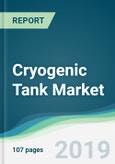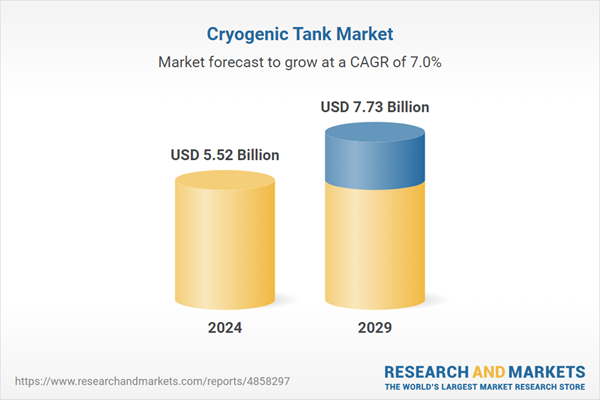The cryogenic tank market is estimated to expand at a CAGR of 6.96% over the projected period, from US$5.522 billion in 2024 to account for US$7.731 billion by 2029.
The cryogenic tanks are designed to safely and efficiently store liquid gases for safe transportation utilized by diverse industry sectors. These tanks are designed to store and ship cryogenic liquids like liquid oxygen, helium, nitrogen, hydrogen, and many others. These gases have different boiling points, generally below negative 150° Celsius. Cryogenic tanks offer several benefits to the end-users, as they offer minimal storage loss of the gases. They are also available in various sizes and varieties to meet the storage needs of different industries. These gases also offer heat preservation and protection for different environmental conditions like rain, heat, and snow.
The healthcare industry worldwide has seen a massive boost in recent decades. Within the healthcare industry, cryogenic tanks are utilized for storing liquified gasses like oxygens, nitrogen, and helium, for medical treatments. The Ministry of Health and Family Welfare of the Indian Government stated that the country had around 26,774 total hospitals within the country, counting 15,041 public hospitals within the country in 2023-24 and around 11,733 private hospitals. The USA, moreover, saw an increment in its total hospital foundation in the country in the past two years. As per the American Hospital Association, the country had almost 6,093 total hospitals in 2022, which expanded to around 6,120 in 2024.
The cryogenic tank market is estimated to grow moderately, fueled by the growing focus on advanced medical treatment. This will require the storing and transporting of medical supplies, and government initiatives to utilize clean energy sources are driving the demand for cryogenic tank market expansion. In addition, technological advancement and the development of efficient cryogenic storage tanks will bolster the way for future market growth.
Global energy and power consumption has observed a major increase, with the increase in the availability of electricity to every household. The U.S. Energy Information Administration (US EIA), in its 2023 report, stated that the nation’s energy production increased massively in recent years. According to the agency, the energy production of the states measured in 2020 was about 95.6 quadrillion British Thermal Units (BTU), which increased to 98.2 quadrillion BTU in 2021 and about 102.9 98.2 quadrillion BTU in 2022.
In addition, the developing healthcare segment in India is resulting in an upsurge in demand for medical gasses like liquid oxygen and nitrogen, which require cryogenic storage arrangements for the storage and transportation of these medical products. This requirement is fueled by the growing number of research institutions, hospitals, and diagnostic centers
According to NITI Aayog data published in 2021, the Indian healthcare industry is anticipated to reach $372 billion by 2022 from $280 billion in 2020, a 22% CAGR increase from 2016. This increment will potentially contribute to the rise in market growth in the coming years.
In addition, the Indian government's push for clean energy sources like Liquefied Natural Gas (LNG) is expanding the requirement for cryogenic tanks for the effective transportation and distribution of LNG. Moreover, key companies operating in India are also effectively contributing to the market growth by manufacturing and providing cryogenic tanks to the country and abroad. For instance, in 2022, Inoxcva, India's largest cryogenic equipment producer, shipped a 238kl liquid hydrogen storage tank for the first liquid hydrogen plant in South Korea and additionally, four 311kl tanks for the development of three more plants in the country. These will result in the rise of the cryogenic tank for diverse utilization by industries thus contributing to the market expansion in the years ahead.
The cryogenic tanks are designed to safely and efficiently store liquid gases for safe transportation utilized by diverse industry sectors. These tanks are designed to store and ship cryogenic liquids like liquid oxygen, helium, nitrogen, hydrogen, and many others. These gases have different boiling points, generally below negative 150° Celsius. Cryogenic tanks offer several benefits to the end-users, as they offer minimal storage loss of the gases. They are also available in various sizes and varieties to meet the storage needs of different industries. These gases also offer heat preservation and protection for different environmental conditions like rain, heat, and snow.
The healthcare industry worldwide has seen a massive boost in recent decades. Within the healthcare industry, cryogenic tanks are utilized for storing liquified gasses like oxygens, nitrogen, and helium, for medical treatments. The Ministry of Health and Family Welfare of the Indian Government stated that the country had around 26,774 total hospitals within the country, counting 15,041 public hospitals within the country in 2023-24 and around 11,733 private hospitals. The USA, moreover, saw an increment in its total hospital foundation in the country in the past two years. As per the American Hospital Association, the country had almost 6,093 total hospitals in 2022, which expanded to around 6,120 in 2024.
The cryogenic tank market is estimated to grow moderately, fueled by the growing focus on advanced medical treatment. This will require the storing and transporting of medical supplies, and government initiatives to utilize clean energy sources are driving the demand for cryogenic tank market expansion. In addition, technological advancement and the development of efficient cryogenic storage tanks will bolster the way for future market growth.
CRYOGENIC TANKS MARKET DRIVERS:
The global increase in energy production and consumption is anticipated to boost the cryogenic market expansion.
Rising global energy production and consumption are forecasted to boost the market demand for cryogenic tanks. In the energy and power industry, they are used to produce liquid natural gases. They provide an optimum and safe storage and transportation solution for liquefied natural gases.Global energy and power consumption has observed a major increase, with the increase in the availability of electricity to every household. The U.S. Energy Information Administration (US EIA), in its 2023 report, stated that the nation’s energy production increased massively in recent years. According to the agency, the energy production of the states measured in 2020 was about 95.6 quadrillion British Thermal Units (BTU), which increased to 98.2 quadrillion BTU in 2021 and about 102.9 98.2 quadrillion BTU in 2022.
Cryogenic Tank Market Geographical Outlook
India is predicted to contribute at a substantial pace to market growth
The cryogenic tank market in India is anticipated to develop due to the rising industrial utilization for storing and transporting gases such as liquid nitrogen, oxygen, and LNG at extremely low temperatures. Government-led initiatives and activities to give rise to diverse sectors will also promote expanding demand for cryogenic tanks. Furthermore, India's natural gas utilization is predicted to grow by 25 billion cubic meters annually, with an average yearly growth rate of 9% until 2024. These natural gases will demand a cryogenic tank for convenient storage and distribution processes.In addition, the developing healthcare segment in India is resulting in an upsurge in demand for medical gasses like liquid oxygen and nitrogen, which require cryogenic storage arrangements for the storage and transportation of these medical products. This requirement is fueled by the growing number of research institutions, hospitals, and diagnostic centers
According to NITI Aayog data published in 2021, the Indian healthcare industry is anticipated to reach $372 billion by 2022 from $280 billion in 2020, a 22% CAGR increase from 2016. This increment will potentially contribute to the rise in market growth in the coming years.
In addition, the Indian government's push for clean energy sources like Liquefied Natural Gas (LNG) is expanding the requirement for cryogenic tanks for the effective transportation and distribution of LNG. Moreover, key companies operating in India are also effectively contributing to the market growth by manufacturing and providing cryogenic tanks to the country and abroad. For instance, in 2022, Inoxcva, India's largest cryogenic equipment producer, shipped a 238kl liquid hydrogen storage tank for the first liquid hydrogen plant in South Korea and additionally, four 311kl tanks for the development of three more plants in the country. These will result in the rise of the cryogenic tank for diverse utilization by industries thus contributing to the market expansion in the years ahead.
CRYOGENIC TANK MARKET RESTRAINTS:
High upfront cost and maintainability could hinder the market expansion of cryogenic tanks.
Cryogenic tanks are costly due to their specialized materials and complex design, which can be an obstruction for potential clients. The cost of operating the tank, including refrigeration systems and monitoring gear, can be expensive. Standard maintenance by trained experts can be costly and impact cryogenic innovation ventures. Furthermore, producers may have less capital to contribute to research and improvement of more affordable and advanced cryogenic tank plans or materials, restricting the potential future expansion.Cryogenic Tank Key Market Developments:
- April 2023- The National Composites Centre (NCC) created a concept design device for composite hydrogen cryogenic tanks, centering on key parameters such as boil-off rate, hydrogen mass, and dormancy. The instrument, created over 12 months by NCC engineers, optimizes hydrogen cryogenic tank plans as per the necessities of the customers.
Cryogenic Tank Market Key Players:
- Gardner Cryogenics - Gardner Cryogenics is a leading company in the storage and transportation of cryogenic gases, particularly liquid hydrogen and helium, for various industrial applications.
- Linde Aktiengesellschaft - It is a prominent industrial gas company that offers a diverse range of cryogenic tank products. These include standardized and customized options for efficient production and required industrial applications.
- Taylor-Wharton - Taylor-Wharton provides a variety of bulk cryogenic storage tanks for transporting and storing liquefied gases, including oxygen, nitrogen, carbon dioxide, and argon.
Market Segmentation:
The Cryogenic Tank Market is segmented and analyzed as below:
By Type of Cryogenic Liquid
- Liquid Nitrogen
- Liquid Argon
- Liquid Helium
- Liquid Oxygen
- Others
By End-User Industry
- Healthcare
- Electronics
- Food & Beverage
- Energy & Power
- Others
By Geography
- North America
- United States
- Canada
- Mexico
- South America
- Brazil
- Argentina
- Others
- Europe
- Germany
- France
- United Kingdom
- Italy
- Others
- Middle East and Africa
- Israel
- Saudi Arabia
- Others
- Asia Pacific
- Japan
- China
- South Korea
- India
- Others
Table of Contents
1. INTRODUCTION
2. RESEARCH METHODOLOGY
3. EXECUTIVE SUMMARY
4. MARKET DYNAMICS
5. CRYOGENIC TANK MARKET BY TYPE OF CRYOGENIC LIQUID
6. CRYOGENIC TANK MARKET BY END-USER INDUSTRY
7. CRYOGENIC TANK MARKET BY GEOGRAPHY
8. COMPETITIVE ENVIRONMENT AND ANALYSIS
9. COMPANY PROFILES
Companies Mentioned
- Linde Aktiengesellschaft
- Gardner Cryogenics
- Taylor-Wharton
- Wessington Cryogenics
- Cryofab
- FIBA Technologies, Inc.
- Chart Industries
- INOXCVA
Methodology

LOADING...
Table Information
| Report Attribute | Details |
|---|---|
| No. of Pages | 124 |
| Published | July 2024 |
| Forecast Period | 2024 - 2029 |
| Estimated Market Value ( USD | $ 5.52 Billion |
| Forecasted Market Value ( USD | $ 7.73 Billion |
| Compound Annual Growth Rate | 6.9% |
| Regions Covered | Global |
| No. of Companies Mentioned | 8 |









